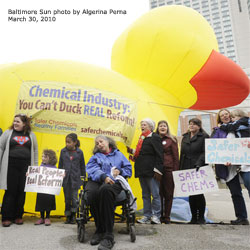 Our campaign created a bit of a ‘flap’ in Baltimore today by bringing an unexpected guest to the chemical industry’s annual GlobalChem conference. Our giant rubber duck and its non-feathered friends attracted reporters and focused public attention on the fact that there are stark differences between how health advocates define TSCA reform, and how the chemical industry defines reform. Our rally was covered by the Baltimore Sun:
Our campaign created a bit of a ‘flap’ in Baltimore today by bringing an unexpected guest to the chemical industry’s annual GlobalChem conference. Our giant rubber duck and its non-feathered friends attracted reporters and focused public attention on the fact that there are stark differences between how health advocates define TSCA reform, and how the chemical industry defines reform. Our rally was covered by the Baltimore Sun:
Standing in front of a giant rubber duck, which came to symbolize toy safety after it was used in nationwide protests of phthalates in the toys, Andy Igrejas, campaign director for Safer Chemicals, Healthy Families, said the public won’t tolerate “phony” reform. “After protests, Congress eventually banned some phthalates in toys,” he said. “But phthalates are the tip of the iceberg. … Parents are getting angry. States are passing laws and Congress is looking at reform.”
Other speakers included Barbara Sattler, RN, DrPH, FAAN, from the Alliance of Nurses for Healthy Environments; Jenny Levin from Maryland PIRG; Cynthia Bearer, MD, PhD, Professor of Neonatology, University of Maryland School of Medicine; and Ariana Kelly from MomsRising.org. The rally was also covered by Chemical Week, Greenwire, and the Daily Green. Andy’s blog defining the differences between our position and the chemical industry’s position was published in the Huffington Post and Alternet. The Daily Green provided a nice summary of how our stance contrasts with the chemical industry’s position:
- Advocates believe chemicals should be regulated like pesticides and drugs: They should be proved safe before being allowed into commerce.
- The industry believes only priority chemicals defined by the EPA should be tested and considered for tighter regulation
- Advocates believe chemicals the EPA has already defined as likely hazardous should be regulated now.
- The industry believes detailed new risk assessments should precede any regulation.
- Advocates believe chemicals should be studied in ways that assess the cumulative effect of exposure to multiple chemicals simultaneously.
- The industry believes the health effects of only some chemicals should be studied, each in isolation and without reference to cumulative exposure.



